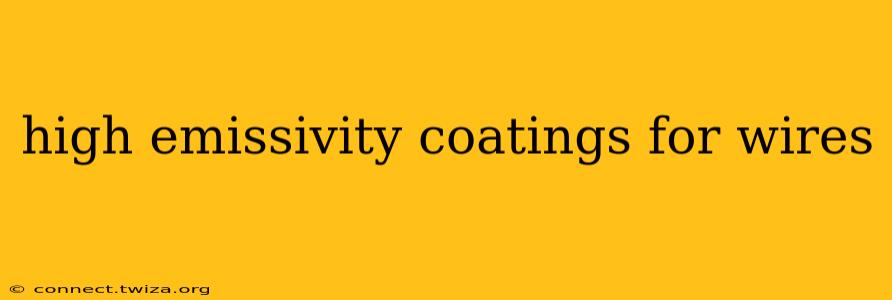High emissivity coatings are playing an increasingly crucial role in various industrial applications, particularly where efficient heat dissipation is paramount. For wires, these coatings offer significant advantages, improving performance, extending lifespan, and enhancing overall system efficiency. This article delves into the world of high emissivity coatings for wires, exploring their benefits, applications, and considerations for selection.
What are High Emissivity Coatings?
High emissivity coatings are specialized surface treatments designed to maximize the infrared radiation emitted by a material. Emissivity, represented by the Greek letter ε (epsilon), is a measure of a material's ability to radiate thermal energy. A perfect blackbody radiator has an emissivity of 1.0, while most materials have emissivities significantly lower. High emissivity coatings typically boast emissivities above 0.8, substantially increasing the rate of heat transfer through radiation. This is crucial in many wire applications where heat management is critical.
Why Use High Emissivity Coatings on Wires?
The application of high emissivity coatings on wires offers several key advantages:
-
Improved Heat Dissipation: The primary benefit is the enhanced ability to dissipate heat. This is particularly important in high-power applications where excessive heat can lead to wire failure or system malfunctions. The coating allows for faster cooling, preventing overheating and maintaining optimal operating temperatures.
-
Increased Efficiency: By improving heat dissipation, these coatings contribute to increased overall system efficiency. Less energy is wasted as heat, resulting in cost savings and reduced environmental impact.
-
Extended Wire Lifespan: Reducing operating temperatures significantly extends the lifespan of wires, delaying degradation and preventing premature failures. This translates to reduced maintenance costs and increased system reliability.
-
Improved Safety: Preventing overheating minimizes the risk of fire hazards and other safety concerns associated with excessively hot wires.
What Types of High Emissivity Coatings are Used for Wires?
Several types of high emissivity coatings are suitable for wire applications, each with its own properties and advantages:
-
Ceramic Coatings: Ceramic coatings, often based on oxides like alumina or zirconia, offer excellent thermal stability and high emissivity. They're suitable for high-temperature applications and provide good corrosion resistance.
-
Paint Coatings: Specialized high-emissivity paints provide an economical and easy-to-apply solution. These paints are often formulated with ceramic particles or other emissivity-enhancing additives. However, they may have lower thermal stability than ceramic coatings.
-
Metallic Coatings: Certain metallic coatings, such as those based on nickel or aluminum, can also exhibit high emissivity. These coatings may offer good conductivity as well, although their emissivity may not be as high as ceramic options.
What are the different types of high emissivity coatings for wires?
This question addresses the types of coatings discussed above. The choice depends heavily on the specific application requirements, including operating temperature, desired lifespan, cost constraints, and the environment the wire will operate in.
How are high emissivity coatings applied to wires?
The application method depends on the type of coating. Paint coatings are applied via spraying, dipping, or brushing. Ceramic coatings often require more sophisticated techniques such as plasma spraying or chemical vapor deposition to achieve a uniform and durable coating.
What are the benefits of using high emissivity coatings on wires in high-temperature applications?
In high-temperature applications, the benefits are amplified. The improved heat dissipation prevents thermal runaway, extends the lifespan of the wire significantly, and reduces the risk of fire hazards. The choice of coating material becomes even more critical, favoring high-temperature-resistant ceramics.
How do high emissivity coatings compare to other methods of heat dissipation for wires?
High emissivity coatings provide a passive method of heat dissipation, relying on radiative heat transfer. Other methods include forced convection (using fans or air flow), conduction (through heat sinks), and combinations thereof. High emissivity coatings are often used in conjunction with these other methods for optimal heat management.
What factors should be considered when choosing a high emissivity coating for wires?
Choosing the right coating involves considering factors like:
- Operating temperature: The coating must withstand the operating temperature without degradation.
- Environmental conditions: Exposure to chemicals, moisture, or other environmental factors should be considered.
- Cost: The cost of the coating and the application process should be evaluated.
- Adhesion and durability: The coating must adhere well to the wire and resist wear and tear.
- Emissivity value: A higher emissivity value generally translates to better heat dissipation.
By carefully selecting and applying high emissivity coatings, manufacturers can significantly improve the performance, lifespan, and safety of wires in a wide range of applications, contributing to more efficient and reliable systems.
